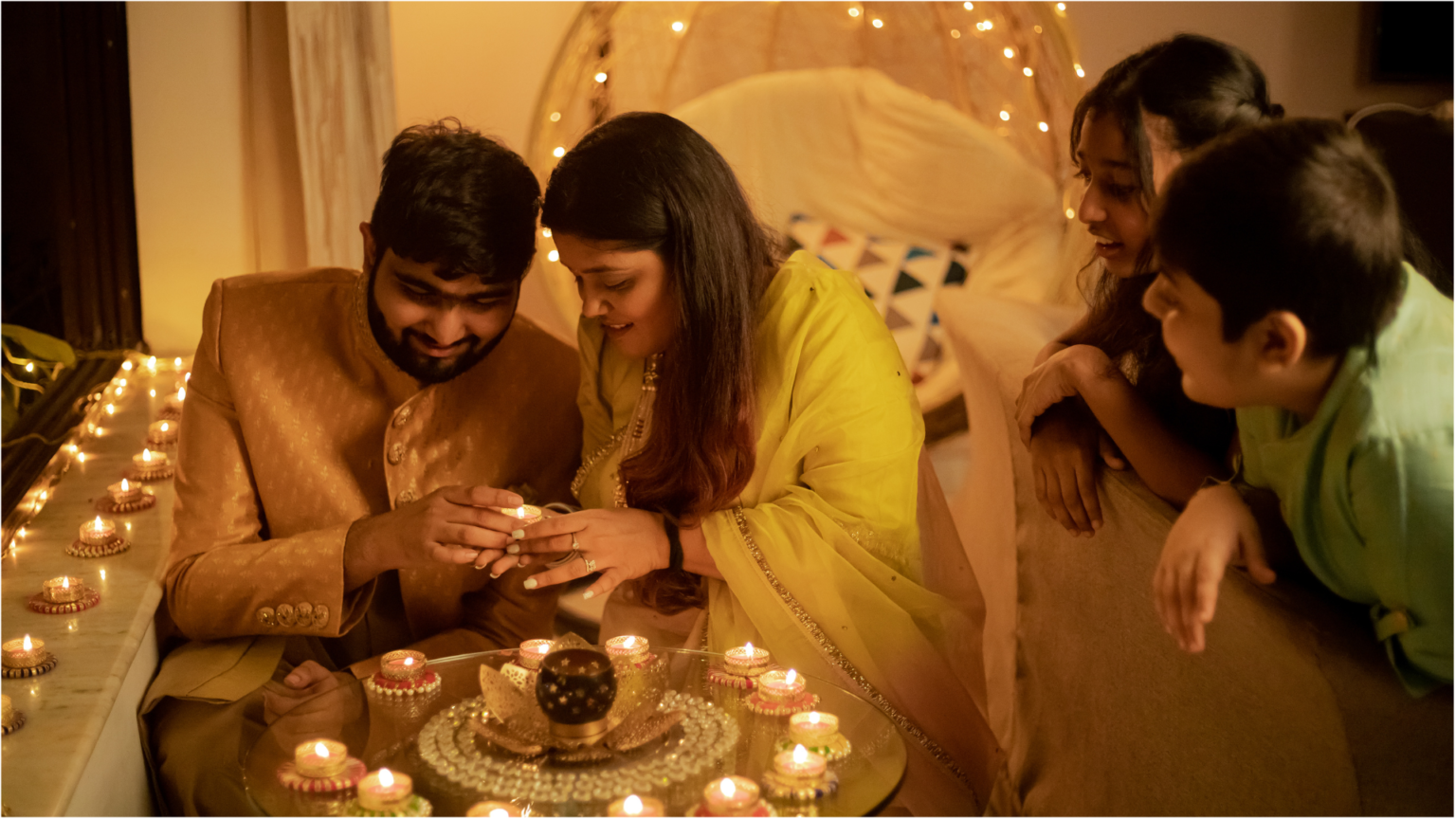Diwali, known the world over as the Festival of Lights, is a celebration of the triumph of good over evil. People light up their homes with diyas (mud or clay oil lamps) and open their doors to family and friends for five days of festivities. This year, the celebrations begin on November 10 and end on November 14. We take a look at the origins of the festival and how it’s celebrated.
What is Diwali?
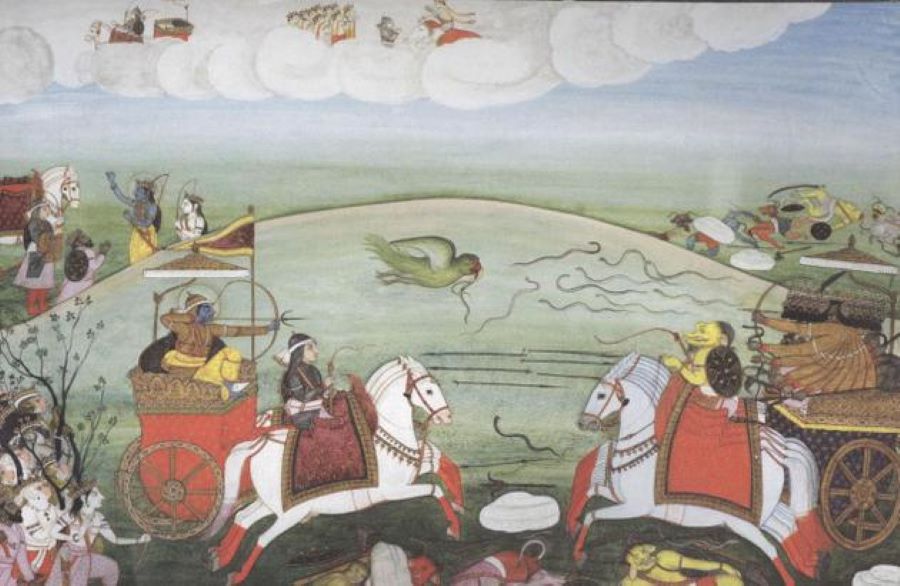
There are varying ways that Hindus across India mark the festival. In North India, it is the commemoration of Prince Rama’s victorious return to Ayodhya after his 14-year exile, during which he rescued his wife Sita from her captor Ravana. In South India, it is known by its Sanskrit name, Deepavali, and is a celebration of Lord Krishna’s defeat of the demon king Narakasura, who imprisoned 16,000 women in his palace and severely punished anyone who stood up to him. Those in west India observe it as the day when the power-hungry King Bali was banished to the underworld.
While Diwali is most well known as a Hindu festival, people of other faiths in India — Sikhs, Jains, and Buddhists — also commemorate it in their own ways. In Sikhism, Diwali is a commemoration of Guru Hargobind’s release after his 12-year imprisonment by Mughal emperor Jahangir. For Jains, this day celebrates when the last of the great Jain teachers, Lord Mahavira, attained nirvana. Buddhists mark it as the day Emperor Ashoka converted from Hinduism to Buddhism.
When and how is Diwali celebrated?
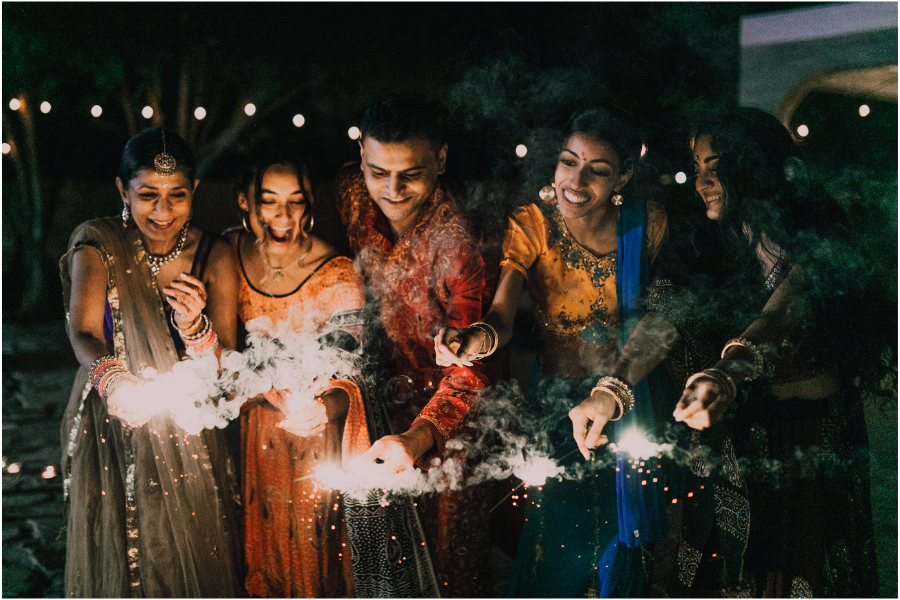
The dates for Diwali change every year based on the Hindu lunar calendar. It begins just before the arrival of a new moon between the months of Asvina and Kartika, which is usually in October or November. In 2023, Diwali begins on November 10 and ends on November 14. The most important day, however, is November 12.
During Diwali, the night skies are usually lit up with fireworks and you’ll hear the sound of crackers bursting in the streets. People also wave sparklers and light chakris (ground-spinners) if they want to have a noise-free celebration.
To prepare their homes to welcome Goddess Lakshmi — the main deity of the festival — people clean them or even renovate them before Diwali. This is also considered an auspicious time to purchase new belongings, so people buy clothes, appliances, cars, and gadgets in the run-up to and the occasion.
The season is also known for taash parties, when people gather to play cards for fun or high stakes. Some popular games are poker, rummy, and blackjack. However, the favourite by far is teen patti, a game in which each player has three cards that they can either play blind or look at. The player with the best hand wins.
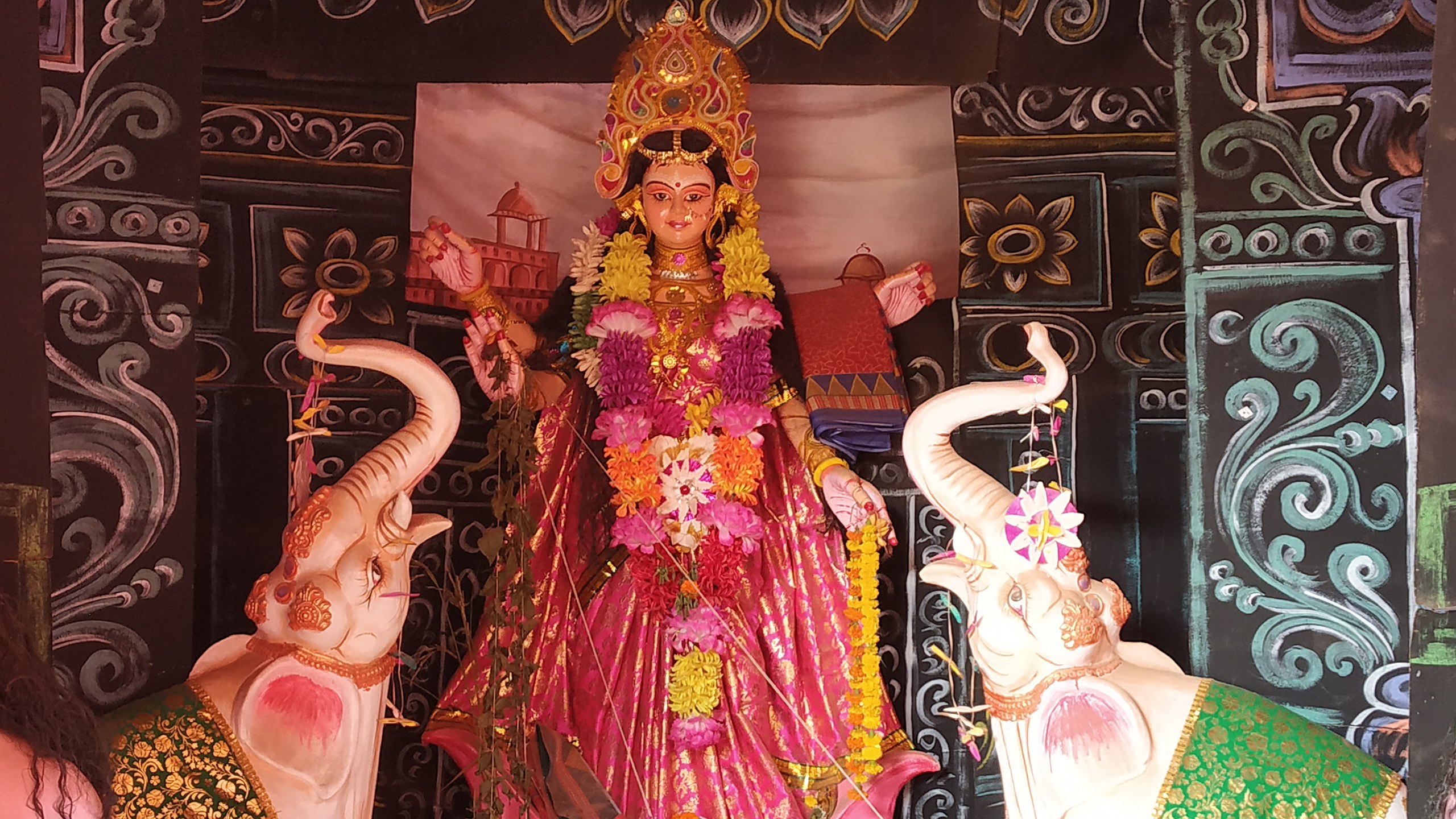
People also perform different pujas — devotional rituals in honour of a deity — on each day of the festival at specific times, and pay visits to family and friends. There are five days of Diwali:
1. November 10: Dhanteras or Dhantrayodashi
On this day, people worship the deities of wealth, Goddess Lakshmi and Lord Kubera. It is also considered auspicious to buy something new, such as gold, silver, clothes or gadgets.
2. November 11: Narak Chaturdashi or Chhoti Diwali
This second day of Diwali, which is the most significant day of the festival in South India, celebrates Lord Krishna’s triumphant return after defeating the demon king Narakasura. This coincides with the commemoration of Lord Vishnu’s victory over King Bali.
3. November 12: Diwali
This is the main day of the festival, which marks the day Lord Rama returned to Ayodhya. It is when people perform the Lakshmi puja and invite the goddess to bless them with luck and prosperity.
4. November 13: Govardhan Puja
The fourth day of Diwali is dedicated to the worship of Lord Krishna, one of the most revered divinities in India. Devotees who perform this puja do it to honour the day Lord Krishna saved the people of Vrindavan from the wrath of Lord Indra, the god of rain and storms, by lifting a mountain named Govardhan.
5. November 14: Bhai Dooj
The last day of Diwali, Bhai Dhooj, celebrates the bond between brothers and sisters. Brothers visit their sisters and exchange sweets and gifts with each other. Sisters pray for the long life of their brothers, put a tilak (a vermillion mark on the forehead) on them, and perform aarti (a part of a puja in which light, usually a flame, is offered to a deity).
How do you wish someone on Diwali?
It’s perfectly acceptable to say “Happy Diwali” if you’re invited to someone’s home or want to wish them for the festival. If you’d prefer to say the same thing in Hindi — the official language of India, apart from English — it’s “Shubh Diwali”.
Given that it’s a festival that celebrates light and good fortune, greeting cards you send — both online and accompanying a gift — can have messages that read, “May the divine light of Diwali fill your life with prosperity, peace, and good health”. If someone wishes you for Diwali, you can reply by simply saying, “Happy Diwali.”
What do people eat during Diwali and where to buy treats in Hong Kong?
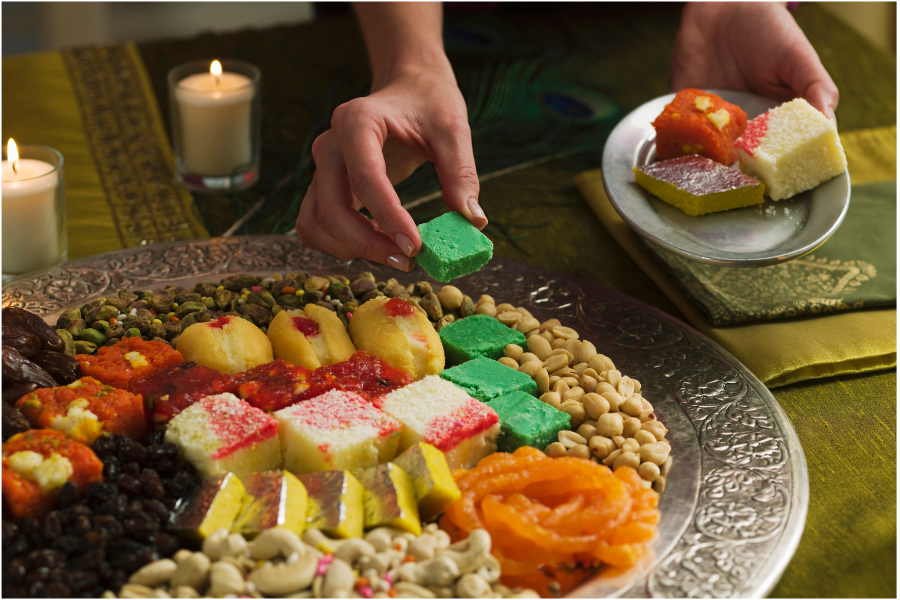
Diwali is a time when most people indulge their sweet tooth. They buy mithai — a variety of sweets usually made of flour, milk, sugar and nuts — and serve them to guests. Some of the most popular mithai served during this time are laddoos (sphere-shaped sweets made with gram flour), barfi (milk-based sweets mixed with nuts and spices, cut into different shapes, with a thin layer of silver leaf on top), and halwa (chewy puddings usually made of carrot or semolina).
If all that’s a bit too rich for you, there are savoury options as well. Favourites include chivda (a spiced Bombay mix made up of dried ingredients, such as chickpeas, peanuts, fried onion and fried lentils), samosas (fried pasty pockets usually filled with a spiced potato mixture), and aloo tikki (small, fried potato patties). You can put together an assortment of these sweet and savoury snacks and take them as gifts for friends who invite you over for Diwali celebrations.
Here’s our pick of places you can get Diwali treats from across Hong Kong and online:
- Spice Store: This online store has a special Diwali hamper comprising a variety of mithai and incense sticks, priced at HK$499. You can even choose sweet boxes with an assortment of mithai, or specific sweets like ladoos (spherical sweets made of sugar syrup or jaggery) and gulab jamuns (doughnuts made out of milk solids and flour) — all priced from HK$30-HK$55. + 852 2944 2336
- DESI Bazaar: This Mid-Levels shop is stocked with a variety of Indian produce if you want to make Indian sweets from scratch. They also have the readymade versions if you’re in a hurry. Shop 4, 120 Caine Road, Mid-Levels, Hong Kong | +852 2987 4555
- Star Mart: Order your Diwali sweets online from their website, and other ornamental items like diyas and stickers, or visit any of their stores across the SAR. Various locations | +852 2366 6534
- Maharaja Mart: Those on the lookout for sweets from South India, such as Mysore pak, can check out Maharaja Marts’s store in Tsim Sha Tsui. They also stock the various items needed for a puja, such as incense sticks and camphor, as well as mud diyas. 205, 2nd Floor, Haiphong Mansions, 99-101, Nathan Road, Tsim Sha Tsui, Kowloon, Hong Kong | +852 2756 5611
- Gift Hampers: Looking for a luxe Diwali gifting option? Try Gift Hamper’s selection of dry fruits, season fruits, organic tea and Godiva chocolates. You can even add wine or whiskey to your hamper to make it extra-special. +852 2730 0839
What to wear on Diwali and where to buy outfits in Hong Kong?
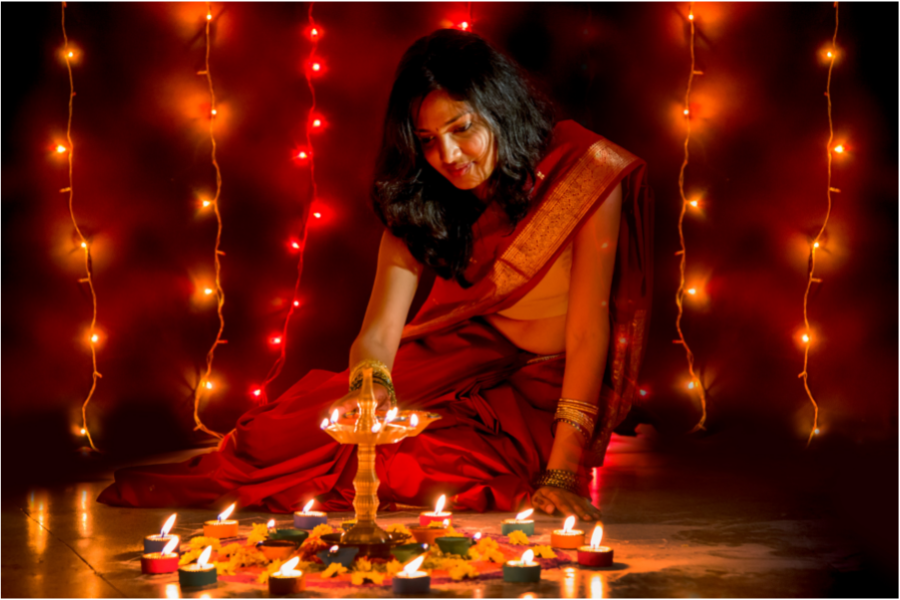
People use this occasion as an opportunity to revamp their wardrobes and jewellery. Women splurge on silk, chiffon or velvet sarees, or lehengas (ankle-length skirts) with matching cholis (bodices). Men, on the other hand, usually wear modern kurtas and dhotis. Those who celebrate Diwali in a big way get more than one outfit as the festivities span several days. They usually get their outfits custom-made for the occasion, but will buy readymade depending on the fashion and fit.
It wouldn’t be Diwali without a little — or a lot! — of dressing up. Here are some places you can head to pick up your festive ensemble:
- Sanskrit: This boutique has designs by more than 30 leading designers from India, where you can find a traditional outfit or something more contemporary. Note that you’ll have to make an appointment to view their offerings. 15th floor, 302 Queen’s Road Central, Central, Hong Kong | +852 2545 2088
- Tabla: This brand, which has been around in Hong Kong for more than 20 years, is your best bet if you want something that’s more east-meets-west. Check out their kurtis, dresses, and shawls to see what we mean. They also have an online store for those who don’t have the time to step out to buy Diwali attire. Shop M31, Mezzanine Floor, Landmark, Prince’s Building, Central, Hong Kong | +852 2525 5590
- Ethnica: If you’ve got your mind set on wearing a saree this Diwali, check out what Ethnica has to offer. The online store sources handmade sarees from all across India and has a range of weaves and fabrics to choose from.
- Fine N’ Rhine: Fine N’ Rhine has been in the business of designing Indian clothes and accessories for Hongkongers for over 35 years. Take your pick from their dhoti sets, kaftans, and kurtis. G/F, Shop D, Lucky Building, 39 Wellington Street, Central, Hong Kong | +852 3118 7338
- Kanta Trading Co.: Last-minute shoppers can find readymade salwar-kameez sets at Kanta Trading Co., as well as sarees and bangles. Cathay Lodge, 3rd Floor, Shop T1-T2, Cathay 88, 125 Wan Chai Rd, Wan Chai, Hong Kong | +852 6970 5313
How to decorate your home and where to buy in Hong Kong?
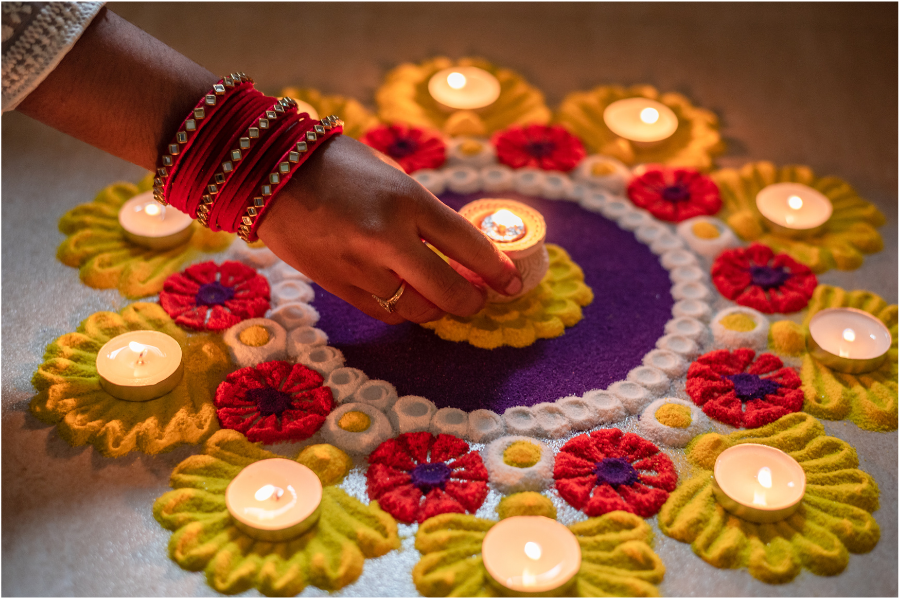
The defining feature of Diwali décor are diyas. In fact, the name of the festival comes from the rows (avali) of clay lamps (deepa) that people light outside their homes as a symbol of the light within that protects them from spiritual darkness.
Another common sight during Diwali is rangoli — colourful geometric patterns commonly made out of rice flour, petals, powdered lime stone or coloured sand, usually drawn in front of doors and entrances to homes. You may notice colourful friezes in doorways made out of leaves, flowers and fabrics. These are torans, which are placed as a sign of welcome to guests, and of course, to Goddess Lakshmi. Walls may be adorned with garlands of flowers and pompoms, while lanterns, candles and fairy lights add a festive play of light to a home during this season.
Most Indian stores sell diyas — both plain and ornamental — as well as a range of other décor essentials for the festival.
- Shop Easy Superstore: The store, which has branches in Tsim Sha Tsui, Central and Tung Chung— stocks garlands, torans, stickers portraying various deities, and acrylic rangoli if you don’t have the time to create one yourself. Various locations | +852 2488 8402
- Candle Up: If you want to give your Diwali lighting some variation, check out what Candle Up has for the season. Many of them are diya-sized and their gift sets work well as Diwali presents. Bonus: They’re 100% soy wax, so they’re clean-burning candles. rhythm_berry@hotmail.com | +852 9616 5214
- Gifts Galore Limited: While you can find garlands and torans at this TST store, check it out for its varied lighting options. Their LED lights in several designs and Lord Ganesha-shaped tea-light candle holders are worth a look. Unit 707, 7/F, Rise Commercial Building, 5-11 Granville circuit, Tsim Sha Tsui, Kowloon, Hong Kong | +852 5478 1232
Header image credits: Studio India via Canva


